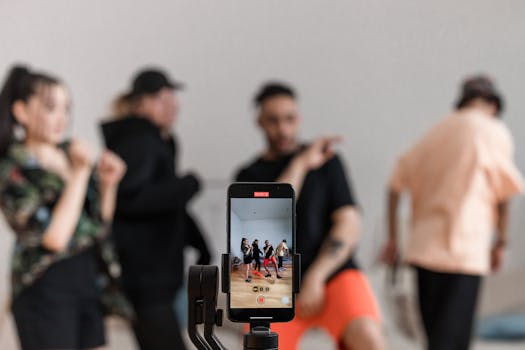Anúncios
Dance marketing has evolved significantly over the years, integrating modern technology and innovative strategies to engage audiences. As emerging trends shape the landscape, it’s essential to explore future tactics and techniques. This article dives into what lies ahead for dance marketing and what professionals should consider to stay relevant.
From social media campaigns to immersive virtual experiences, the approaches to dance marketing are becoming more dynamic. Brands and troupes must adapt to these changes to effectively reach their target audiences. Moreover, understanding the role of analytics and data in shaping marketing strategies is becoming increasingly vital.
The integration of art and digital platforms creates an exciting opportunity. As we look towards the future, let’s examine seven key areas that will define dance marketing, focusing on how they can be leveraged for maximum impact.
The Role of Social Media in Dance Marketing
Social media platforms have revolutionized how dance companies promote their work. They allow immediate access to wide and diverse audiences, fostering community engagement. Continued growth in user-generated content enhances visibility for dancers and troupes.
Platforms like Instagram and TikTok have become essential for showcasing dance talent. Creative short videos can attract attention and increase participation in dance challenges, bringing fresh talent to the forefront. Dancers who harness these platforms effectively can amplify their reach.
Anúncios
Moreover, paid advertising on social media can target specific demographics. This enables dance marketers to tailor campaigns directly to those most likely to engage with their content. Effective targeting can transform the return on investment in marketing efforts.
Live-streaming performances also provides an avenue for wider audience engagement. Dancers can reach viewers globally without venue limits. By creating interactive experiences through social media live streams, dance professionals can build a loyal following.
Overall, social media will continue to transform the marketing landscape, making it easier for dance professionals to connect with audiences. The real-time nature of these platforms allows for constant adaptation, vital for future dance marketing strategies.
Anúncios
Data-Driven Marketing Strategies
Analytics are becoming increasingly important in crafting effective dance marketing campaigns. Understanding audience demographics, preferences, and behaviors helps marketers tailor their approaches. Data-driven strategies enable precision in decision-making.
Marketers should analyze engagement data from previous campaigns. Insights gained from audience interactions allow for continuous improvement across various platforms. Utilizing metrics like reach, engagement, and conversion rates guides better content creation.
Also, A/B testing can help identify which marketing styles resonate most with audiences. Comparing different messages or visuals can lead to enhanced engagement and lower marketing costs. Implementing data analysis into marketing strategies will be a key trend moving forward.
Moreover, user feedback collected through surveys or interaction metrics can inform future campaigns. Engaging audiences in dialogue can lead to more authentic relationships, and marketers can adapt strategies based on direct input. A personal touch is crucial.
In summary, embracing data-driven marketing strategies is essential for staying relevant. As data analytics tools become more sophisticated, dance marketers who leverage these insights will likely succeed in connecting with their audiences.
Embracing Technology and Virtual Experiences
Advancements in technology present new opportunities for dance marketing, particularly through virtual reality (VR) and augmented reality (AR). These technologies can create immersive experiences that can captivate audiences. This innovation elevates traditional marketing.
Virtual reality performances allow audiences to feel part of the action. Viewers can experience performances from anywhere, breaking geographical barriers. This technology facilitates unique artistic expression, optimizing engagement levels.
Similarly, augmented reality can enhance audience interactions. Interactive marketing campaigns using AR can allow users to visualize dance elements in their environment. Such creativity transforms the audience’s perception of dance and involvement.
Furthermore, technology facilitates collaborative works, bringing more artists together regardless of their locations. Virtual collaborations can lead to unique projects broader than traditional partnerships would allow. This connectedness will reshape future dance narratives.
In conclusion, integrating technology in dance marketing invites exciting possibilities. The ability to create immersive and interactive experiences can deeply resonate with audiences, enhancing their connection with the art form.
Building Authentic Brand Partnerships
Forming partnerships with brands can significantly enhance dance marketing visibility. Collaborating with organizations that align with a dance company’s values leads to mutually beneficial outcomes. Effective partnerships help establish credibility within the industry.
Innovative brand partnerships can focus on events or campaigns that resonate with shared audiences. Cross-promotion enables both partners to leverage each other’s followers, amplifying market reach. The key is finding authentic connections.
Moreover, partnerships can lead to creative collaborations, resulting in unique performances or projects. Such joint efforts can attract diverse audience segments and inspire fresh ideas. Collaborations can redefine traditional boundaries in the dance industry.
Engaging with local businesses can create strong community ties. Promoting local companies alongside dance productions fosters goodwill and enhances visibility. Community-based partnerships can broaden reach and build lifelong supporters for both parties.
Overall, developing authentic brand partnerships will be crucial in dance marketing’s future. Collaborations not only enhance visibility but also establish deeper connections with audiences, promoting shared values and creativity.
Content Marketing and Storytelling
Effective storytelling through content marketing is vital for dance companies. Developing compelling narratives around performances can create emotional connections with audiences. Stories can differentiate organizations from competitors in saturated markets.
Content marketing offers opportunities to share dancer backgrounds, rehearsal processes, and performance stories. Engaging narratives about the creative journey invite audiences to invest in the art personally. People connect with stories beyond the performance itself.
Moreover, video content is particularly effective for storytelling. Short documentaries or behind-the-scenes footage can deeply engage viewers. This transparency enhances the allure of dance performances, inviting larger audiences.
Visual storytelling through quality imagery and videos can enhance brand identity. By curating a recognizable aesthetic, dance companies can increase audience loyalty. A coherent visual narrative amplifies overall marketing strategies.
In conclusion, prioritizing content marketing and storytelling in dance marketing enhances audience engagement. Performing arts organizations should focus on compelling narratives that resonate deeply with their target audiences, fostering lasting connections.
Emphasizing Community Engagement and Inclusion
Community engagement adds significant value to dance marketing efforts. Fostering inclusive environments attracts diverse audiences, ensuring that dance reaches numerous societal segments. Engaged communities can cultivate robust support for dance initiatives.
Businesses should focus on outreach programs and workshops in local communities. Offering accessible dance classes or performances can cultivate interest and invite new participants. Engagement encourages diversity, enriching the dance community.
Inclusive marketing messages that reflect various backgrounds will resonate more profoundly. Audiences appreciate brands that represent their values and experiences authentically. Building an inclusive narrative can invite greater overall participation.
Moreover, collaboration with schools and community organizations can extend outreach. Educational initiatives in dance can inspire the next generation of dancers and audiences. Strong community ties lead to a more engaged local audience.
In summary, prioritizing community engagement fosters inclusivity in dance marketing. Encouraging participation from diverse backgrounds not only strengthens support but enhances the overall vitality of dance as an art form.
Conclusion
As dance marketing continues to evolve, various factors will play pivotal roles in shaping its future. Emphasizing social media, data-driven strategies, innovative technologies, authentic partnerships, storytelling, and community engagement will be crucial. By embracing these elements, dance professionals can connect with their audiences more effectively.
The future of dance marketing is exciting and full of potential. Dance companies willing to adapt and innovate are likely to thrive in this dynamic landscape. Through a combination of creativity and modern technology, the possibilities are endless.
Ultimately, the journey into the future of dance marketing requires a commitment to exploration and engagement. By staying proactive, the dance community can pave the way for vibrant and meaningful connections with diverse audiences around the world.
| Key Area | Importance | Future Trends |
|---|---|---|
| Social Media | Immediate audience access | Visual content growth |
| Data-Driven Strategies | Informed decision-making | A/B testing and analysis |
| Technology Integration | Immersive experiences | AR and VR innovations |
| Brand Partnerships | Enhanced visibility | Creative collaborations |
| Storytelling | Emotional connections | Video and imagery focus |
| Community Engagement | Diverse audience cultivation | Accessible outreach |
- Leverage social media for engagement
- Employ data analytics to refine strategies
- Incorporate emerging tech like VR and AR
- Form powerful brand partnerships
- Create compelling content and narratives
- Encourage community involvement and inclusivity



